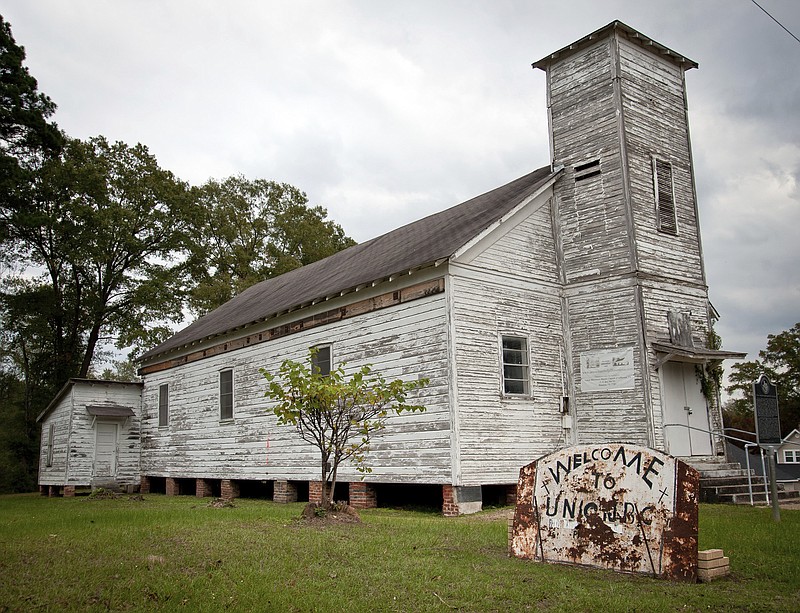JEFFERSON, Texas-For more than 100 years the Union Missionary Baptist Church has stood proudly at its 520 Houston St. location, having sustained fires both literal and figurative throughout the tumultuous Reconstruction period following the Civil War.
The Marshall News Messenger reports that today, representatives from the Collins Academy, the Texas Historical Commission and several volunteers have begun to chip away at the church's century of history, hoping to discover more about those who built it.
"We're doing an archaeological salvage out here," Collins Academy Director Gary Endsley recently said. "We are looking in particular for the footprint of the first structure that burned in Oct. 4, 1868 .. One of our basic questions is, 'who was the first congregation?'"
"We're trying to understand them. We're talking about people who were pioneers in Texas building a black church," Texas Historical Commission Steward Bob Vernon said.
Vernon was on hand to offer his expertise throughout the dig, mapping the site's findings. THC stewards record and monitor archaeological sites as well as help obtain protective designations and record private artifact collections.
Endsley said once the salvage effort is complete in a few weeks, restoration efforts can begin.
"We have to do this to get on with the next steps, which will be the asbestos abatement and the demolition of certain parts (of the church)," Endsley said. "Then we'll be able to start reconstruction."
Endsley tracks the beginning of the UMBC back to 1842 when one of Jefferson's founders, Capt. William Perry, and his wife gave three 50 by 150 foot lots of his land so slaves and freedmen could have a place to worship.
Slaves and freedmen alike worshipped under tents on the land until building the first church structure in 1847. But during Reconstruction, the church burned to the ground in 1868, shortly after UMBC was officially established.
The first step to the archaeological process, Vernon said, are to identify where the original site of the church sat. Vernon said it is thought when the church was rebuilt around 1883, it was positioned closer to the road, shifting the original church site slightly.
"We put down test holes, the ones (we've marked as) black (on the map) is where charcoal has showed up," Vernon said, pointing at the 15 holes planted behind the UMBC. "We don't know (if it's shifted). That's what we're trying to find out. That's why we're digging these squares around the church."
Vernon likens the archaeological process of locating the original site of the church to trying to put together a puzzle; you have to find a corner piece first.
"Ideally, we'd like to locate all four corners," Vernon said. "One is probably under the church, but we might be able to find three and extrapolate the other."
Vernon identified the church's baptistery as a place that would likely yield results as the dig continued.
"It may have been filled in for safety," Vernon said of the baptistery. "But people always throw stuff in holes. After a couple of feet, we'll probably find a lot of crazy things people threw away in the baptistery. It's just a human thing, if you have a hole, people will throw things in it."
Vernon said he witnessed other sites where, by looking in a cistern, archaeologists were able to determine how people of other time periods lived.
"You could watch time pass," Vernon said. "We could see at the bottom there were steak bones, but went to pork chops, then catfish bones and finally alligator gar bones as we went through the Great Depression. But then things got better and we saw them get back up to steak, but what (is in the baptistery) may give us a lot of information."
Endsley said though the dig is in its fledgling stages, there has already been several finds, including nails and tiny fragments of pottery.
"Our best find so far has been a wedding ring," Endsley said. "It probably goes back to the 1840s or 50s. It was found some 60 centimeters down inside of a layer of charcoal that we think represents the 1847 structure."
"The slave culture had surprisingly stable marriages," Vernon said. "As long as the couple wasn't broken up and sold apart, they had extreme monogamy. That's why these wedding rings show up. You wouldn't think a slave would be wearing wedding rings. Well, they may not have had much, but they made something that marked them."
Endsley said eventually the goal will be to renovate the UMBC into a heritage center, which will serve as a museum displaying the timeline and story of the church. Endsley said he hopes members of the UMBC congregation, who are still around today and meeting in churches and homes throughout Jefferson, will be able to return to worship in the renovated facility.

